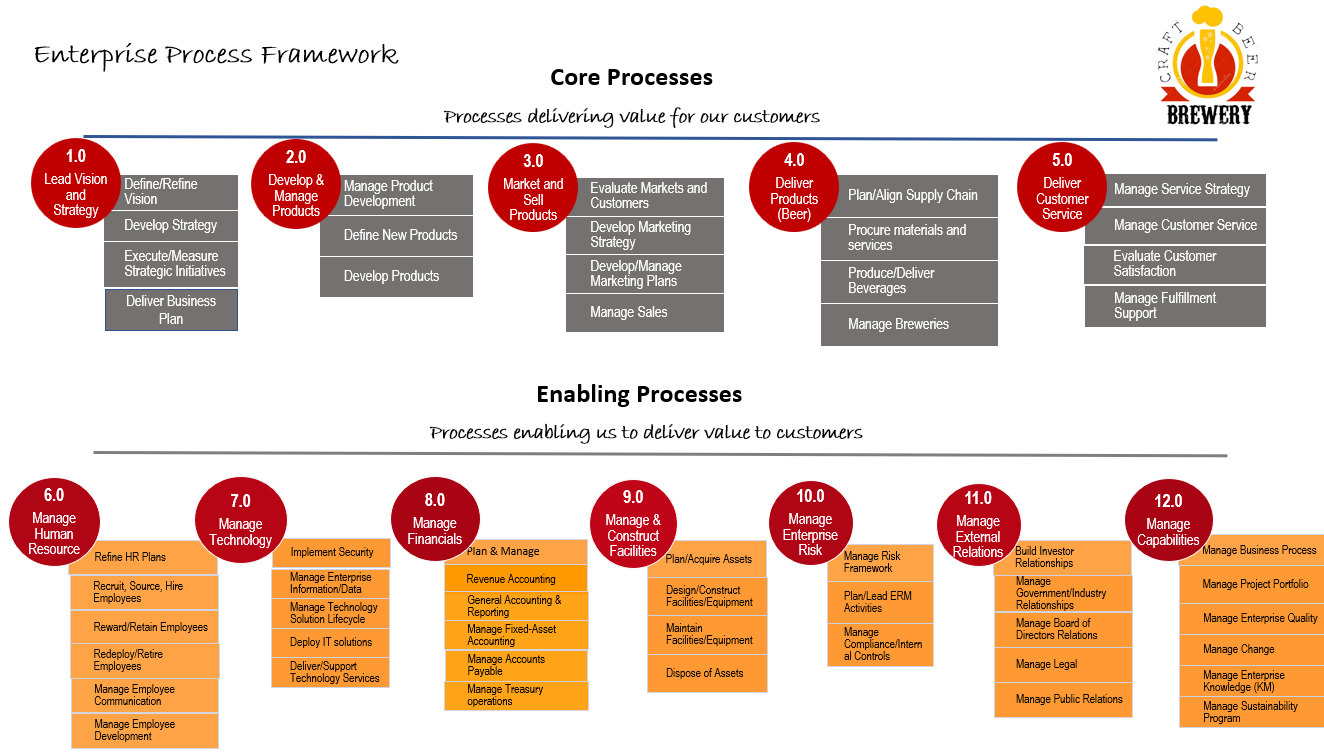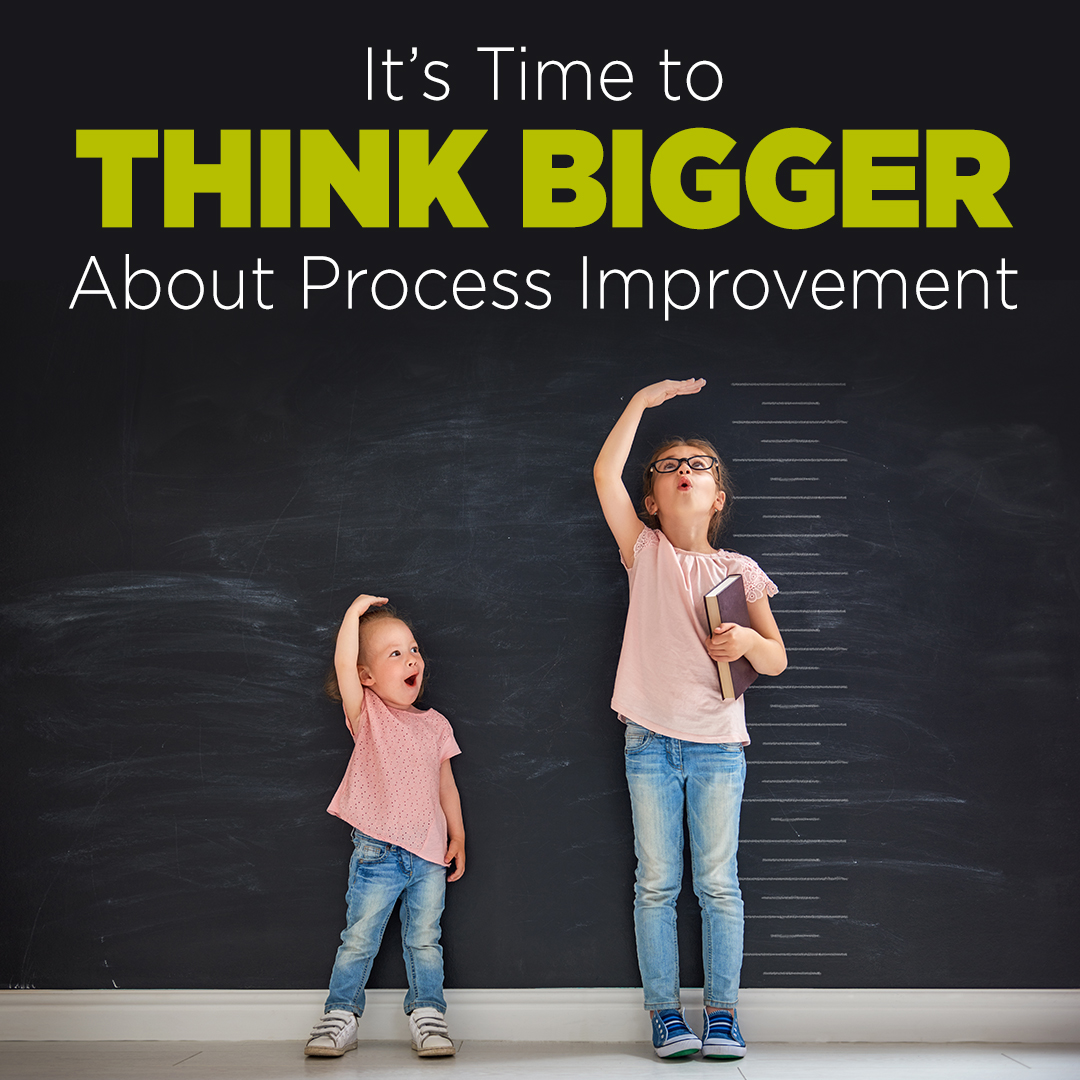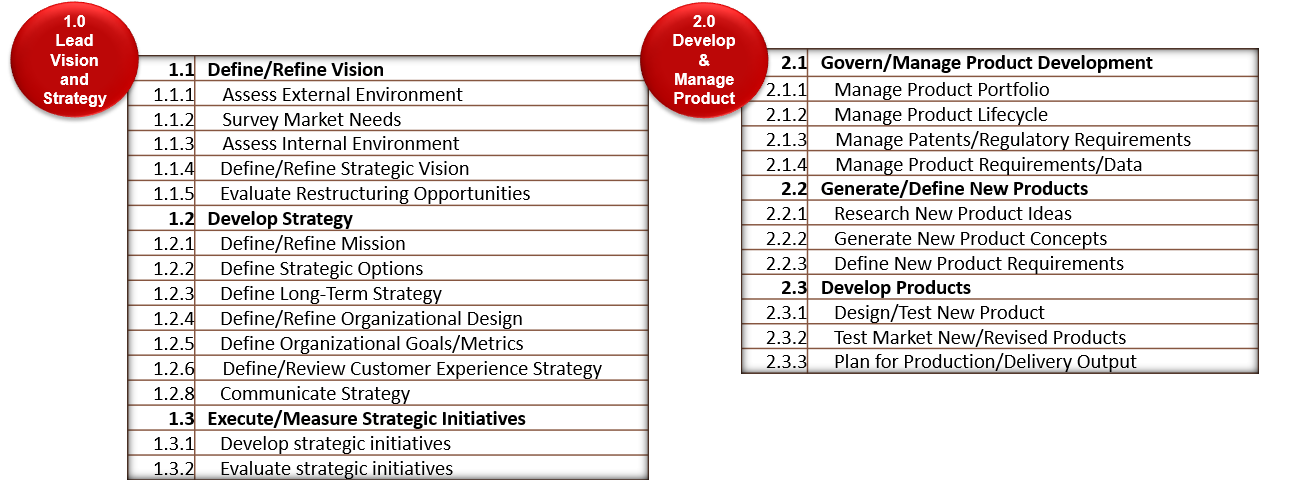An enterprise process framework provides system-wide insight and transparency into challenging and complex situations very quickly. It is home to transparent working processes with linked inputs and outputs providing an incredibly rich platform for holistic improvement.
Enterprise Process Framework Overview

The Basics
 The enterprise process framework provides both architecture and a taxonomy for your business processes. It provides a common, visual, logically organized repository of deployed processes. And, it supports both operational activities as well as innovation opportunities.
The enterprise process framework provides both architecture and a taxonomy for your business processes. It provides a common, visual, logically organized repository of deployed processes. And, it supports both operational activities as well as innovation opportunities.
The enterprise process framework is unique to each organization. But, the purpose is the same, the organization gains a mutual shared understanding of how work gets done across the entire organization. The organization speaks the same process language.
In the basic example above, categories of processes are organized and aligned with the delivery of products to the customer. And, categories are further refined into sub-categories. Categories and processes have assigned ownership. The framework provides differentiation between core process categories and enabling process categories and includes a numbering convention.
When you dive deeper into each category, you find the location of each business process (by name and number). And, within those well-designed and deployed business processes, lives an interconnected super highway of processes. The processes are governed by process owners and are rich with details of requirements, metrics, inputs and outputs.
Enterprise Process Framework Detailed Example

Thinking Bigger
Although the primary value of the enterprise process framework is daily operational insight, it also allows you to ‘go big’ and gain transparency into how work happens across the entire organization. This allows you to evaluate holistic transformational improvements. In the same way a well-deployed process provides visibility into smaller scale improvement opportunities, the enterprise process framework helps you see opportunities on a much broader and deeper scale. Any idea or opportunity can be evaluated from end to end through the linked processes. What is the overall impact? How broad? Which areas of the organization will be impacted? How many processes will be touched? Where are the redundancies? Where are the efficiencies? What is the impact to our customer experience?
In APQC’s 2018 Process and Performance Management survey, 69 percent of respondents indicated they seek efficiencies through process automation. Surely, spending $1 million on new software should bring the desired improvements. But, without the holistic, transparency of an enterprise process framework, it is challenging to really know if this new, forward edge (and likely expensive) solution will, in fact, improve the organization or the customer experience.
It is critical to know exactly how work is getting done today. You can produce a robust request for proposal (RFP) for a vendor when you include the end-to-end process requirements. Rather than looking at high-level, hypothetical applications of new software, you can provide your precise, integrated process requirements. This makes you a better partner with your vendor and definitely increases the probability you select the right solution. You can educate and inform your vendor partner about your upstream/downstream business process inputs/outputs, reducing the ‘gotchas’ of system/software integration issues.
In fact, the development cost of an enterprise process framework is worth every penny when compared to just one unintentional, costly software mistake.
Smarter, not harder
Paradoxically, it is the architecture of an enterprise process framework, that ultimately sets you free to improve and innovate continuously.
Just starting to build an enterprise process framework provides a new enlightened view into the organization of the organization. As the enterprise process framework takes shape, a pipeline of practical and innovative improvements is plainly obvious as the processes connect like pieces in a puzzle.
And, when evaluating potential improvements, an enterprise process framework provides the organization’s delta. Knowing where you are starting is as important as where you are going. Because with an enterprise process framework, no process ever stands alone. Every process is linked, it is possible to identify which and how many processes and stakeholders are impacted, defining the magnitude of change. This guides realistic perspective about scope and required resources for solutions under consideration.
Tapping into an enterprise process framework, leads to improvements that are right-sized to the problem. Automating may or may not be the best solution. But, it likely is the most expensive. And, often there are impactful solutions available regardless if enhanced technology is pursued.
The best part! An enterprise process framework is a dynamic perpetual window into the organization when it is properly managed. Processes are continuously updated reflecting both process and technology improvements. And, when leveraging the enterprise process framework before, during and after the improvements, there is always a steady stream of optimization opportunities.
Carla Wolfe, is the Chief Architect at Art of Process, thought leader, and guest blogger at APQC. In her work she guides organizational optimization leveraging business process architecture and enterprise process frameworks. As vice president at Elevations Credit Union, recipient of the 2014 Presidential Malcolm Baldrige award, she led business process management, business analysis, and project management. You can connect with her at [email protected].